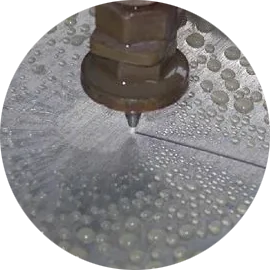Time to read: 6 min

Waterjet and plasma cutting are essential for cutting and fabricating metals and other materials, yet they differ significantly in terms of working principles, material compatibility, and costs. Understanding these differences is crucial for selecting the appropriate cutting technique for your project.
Waterjet vs Plasma Cutting: A Detailed Comparison
Working Principle
-
Waterjet Cutting: Waterjet cutting employs a high-pressure mixture of water and abrasive particles to erode materials. This process can cut virtually any material with precision, making it highly versatile.
-
Plasma Cutting: In contrast, plasma cutting relies on compressed gases and an electric arc to generate extremely hot plasma. This plasma can cleanly cut through conductive metals at high speeds.
Material Selection
-
Flexibility to Materials: Waterjet cutting excels in material flexibility, capable of cutting metals, foams, rubbers, textiles, and more. Plasma cutting is limited to conductive metals but is widely applicable given the prevalence of conductive metals.
-
Material Thickness to Cut: Waterjet cutting can handle thick materials, including steel up to 6 inches thick and even thicker in non-metal applications. Plasma cutting is limited to a 6-inch cut depth in thick mild steel but is optimal for standard metal thicknesses.
During the Process
-
Productivity and Cutting Speed: Plasma cutting offers faster cutting speeds, averaging 200 inches per minute, enhancing productivity for metal cutting. Waterjet cutting, however, is slower, averaging 15 inches per minute.
-
The Complexity of Cuts: Waterjet cutting allows for greater complexity in cutting shapes, offering flexibility for fabricators. Plasma cutting is better suited for simpler cuts due to its straight-line cutting nature.
-
Stress Effects During Cutting: Plasma cutting can cause warping and distortion due to high temperatures, whereas waterjet cutting does not introduce such stress due to the absence of heat.
-
Heat-Related Effects: Plasma cutting may alter the color and chemical composition of materials due to heat. Waterjet cutting avoids these effects as it is a cold cutting process.
-
Environmentally Friendly: Waterjet cutting is more eco-friendly, featuring a closed-loop system for water recycling and minimal waste production. Plasma cutting generates fumes and dross, impacting the environment.
-
Energy Consumption: Plasma cutting consumes more energy due to the requirements of gas pressure and electric arcs. Waterjet cutting is more energy-efficient, primarily needing a high-pressure water pump.
Final Results
-
Product Quality: Waterjet cutting offers superior accuracy with a tolerance of 0.001 inches, resulting in higher quality cuts that often require little to no finishing.
-
Finishing Requirements: Plasma cutting usually necessitates secondary finishing processes, while waterjet cutting produces precise surfaces that typically need no further refinement.
Cutting Machines-Related
-
Safety: Waterjet cutting machines are safer due to the absence of high temperatures and electric currents, whereas plasma cutters require safety precautions due to heat and electric currents.
-
Lifespan: Consumables in plasma cutting have a shorter lifespan due to rapid wear from high pressures and temperatures. Waterjet cutting consumables last longer, reducing production costs.
-
Maintenance: Waterjet cutting requires simpler maintenance due to less complex equipment and fewer consumable parts. Plasma cutting involves more maintenance due to frequent consumable replacements.
Applications
Waterjet cutting's versatility lends itself to applications in various industries, including aerospace and mining. Plasma cutting is suitable for industrial construction and other applications involving thick, conductive metals.
Costs
Plasma cutting machines are generally cheaper upfront and have lower operating costs, making them ideal for large-scale production. Waterjet cutting, while more expensive, offers precision and quality that may justify the higher costs.
Conclusion
The choice between waterjet and plasma cutting depends on your project's specific requirements, including material type, desired precision, environmental considerations, and cost. Each technique has its merits, and the optimal selection will ensure precision-cut parts that meet your quality standards.
UnoFactory offers precision cutting services, including waterjet and plasma cutting, tailored to your manufacturing needs. Our team of dedicated engineers ensures the highest quality parts production. Upload your design files to our platform for a rapid quotation and a free DFM analysis. Contact us today to learn more about how we can support your precision-cutting requirements.




